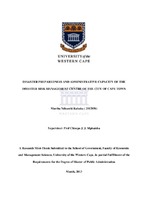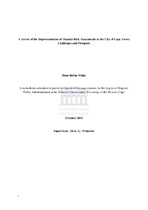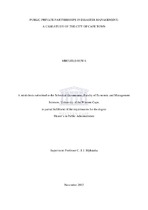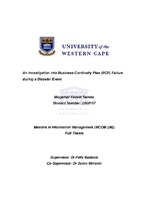| dc.description.abstract | The occurrence of disasters around the world has in the past few decades increased at an alarming rate, which has necessitated an urgent need for mitigation strategies. As part of its planning and precautionary measures in responding to disasters, the City of Cape Town(CoCT) established a Disaster Risk Management Centre (DRMC) to co-ordinate such occurrences. This study is focused on investigating to what extent the CoCT’s DRMC has prepared individuals and communities to stay resilient.South Africa lies within a region of Southern Africa that has a semi-arid to arid climate,thereby making most parts of the country vulnerable to numerous disasters. Given the prevalence of the localised disasters in the country, they have the potential to overwhelm the capacity of any affected community. Furthermore, in 2011, the CoCT was approached by the International Council for Local Environmental Initiatives(ICLEI) to sign up as a Role Model
City for the “Making Cities Resilient--My City is Getting Ready’’ Campaign, in
collaboration with UNISDR. It became the first in South African City to be granted “Role Model City’’ status, becoming the second African city to be designated as a ‘‘Role Model City’’.The findings of this study indicate that the CoCT, through its DRMC, has tried to heighten awareness in communities to prepare them against disasters. Another important finding is that there is inadequate involvement of communities in CoCT training programmes. Poorer communities, which are mostly affected by disasters, barely receive any form of capacity building, that is, through training. In addition, the language of communication used in brochures, leaflets and other forms of media is mostly in English and Afrikaans, while the majority of people living in informal settlements speak isiXhosa. The study provides an
insight into the need to consolidate strategies to address disaster management | en_US |




